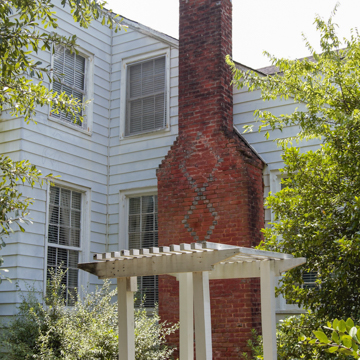Among older residences in Lowndesboro, The Cottage (circa 1830) is of special note. Its brick chimneys offer a rare glimpse in Alabama of “diaper work”: a decorative motif typically in a diamond pattern and here, composed of glazed headers that are worked into the face of each chimney. Originating in medieval Europe and brought to North America in the colonial period, its occurrence in early Alabama is extremely rare. Equally unusual in Alabama are the odd, half-gabled “flounder” wings pushing out from each side of the house, although they do occur at one other Lowndesboro house, The Hideaway. A deep veranda shades the front of the house, its freestanding square pillars (probably 1850s replacements of the originals) positioned well in front of the railed, deck-like veranda itself. Colloquially referred to as a “Carolina porch” from its apparent place of origin, this was a functional response to Deep South climatic conditions, affording extra protection against hot summer sun and heavy rain.
References
Gamble, Robert. The Alabama Catalog – Historic American Buildings Survey: A Guide to the Early Architecture of the State. Tuscaloosa: University of Alabama Press, 1987.
Lowndesboro Heritage Society. Lowndesboro’s Picturesque Legacies. Privately printed, 1994.
Parker, Carolyn Smith. Harbingers of North Lowndes. Privately printed, 2016.














